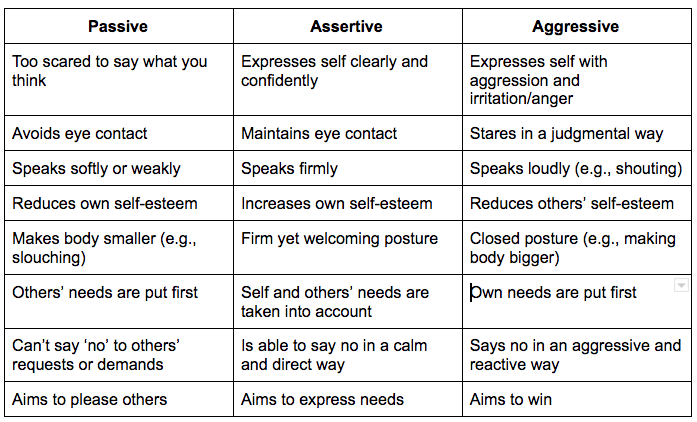
Whether you’re communicating in the workspace or with friends and family, assertiveness is an important element of communication across many domains. Here, you'll learn all about assertive communication.

Have you ever struggled to get your point across in a clear but non-aggressive way? Or, do you have a hard time communicating your needs? Assertive communication can be a useful tool for helping us balance our relationships with getting our own needs met. In this article, we'll talk about passive communication versus aggressive communication versus assertive communication and help you learn how to communicate more assertively.
Before we get started, we thought you might also be interested in taking our well-being quiz to get your free personalized report . Or, if you're a well-being entrepreneur or coach, download our Wellness Business Growth eBook to get expert tips, tools, and resources to grow your business fast.
Are You a Therapist, Coach, or Wellness Entrepreneur?✓ Save hundreds of hours of time ✓ Earn more $ faster
✓ Boost your credibility ✓ Deliver high-impact content
Here’s a scenario that you may have experienced before. You’re on a tight deadline for a specific project (e.g., a school assignment or work task) and have a full plate. One of your close friends happens to get in touch with you during this stressful time and pleads for you to do a last-minute favor for her. You want to say no so that you stay on track, but you also don’t want to come off as a bad friend.
What would you do in this scenario? Perhaps you would put your foot down and say ‘no’, or maybe you have trouble with assertiveness in social interactions, which ends up making you more stressed in the long run.
You’re probably familiar with the term ‘assertive’, but what exactly does assertive communication entail? Assertive communication has been defined as “the ability to speak and interact in a manner that considers and respects the rights and opinions of others while also standing up for your rights, needs, and personal boundaries” (Pipas & Jaradat, 2010, pp. 649).
Put differently, assertive communication involves confidently expressing your needs with an approach that is direct yet calm and reasonable while also taking the other person’s needs into account. This is an important form of communication across a variety of domains in life because it allows you to communicate your wants, needs, or opinions, and stand up for yourself when needed.
It can also help you to feel less guilty for saying ‘no’ to tasks or plans that may not be serving you. The next section will go over the specifics of assertive communication and what it may look like in practice.

What are some characteristics of assertive communication? Pipas and Jaradat (2010) and Bishop (2013) include the characteristics below. The first five concern non-verbal characteristics, and the last four concern verbal characteristics.
1. Direct eye contact : communicates that the person is not intimidated
2. Assertive posture/stance : balance between looking too aggressive and too weak
3. Tone of voice : should be strong, but not aggressive (e.g., raising voice)
4. Facial expression : important to not express anger or anxiety
5. Timing : the person must be socially aware to assertively communicate at the right time (e.g., asking for a raise in the middle of a business meeting is not likely to be well received)
6. Clarity : using specific words that clearly communicate needs
7. Non-threatening : the person should not blame or threaten the other person (e.g., you better do this, or else)
8. Positive : framing a request in a positive way (e.g., “I bought two laundry hampers. Would you please place your laundry in one of them?”) is more effective than a negative request (e.g., “Will you stop leaving your laundry everywhere?”)
9. No criticism : although it might be tempting, it’s important to not criticize yourself (e.g., “I’m overly sensitive”) or others (“Why are you so mean?”) when trying to be assertive
Clearly, there is a fine line between being assertive in your communication and coming off as too aggressive or too passive. Let’s take a closer look at these different aspects of assertive communication and their boundaries.
Let’s take the same example from the beginning. If your friend asks you to do a favor for her but you have a project to focus on, there are three ways you can respond:
Aggressive response : “Absolutely not. You always ask for favors at the last minute! You need to start learning how to manage your life before asking me to drop everything to help you.”
Passive response : “Yeah, of course. No problem at all.”
Assertive response : “As much as I’d love to help, unfortunately, I have a lot of work to get through today. I hope you’re able to find someone else though.”
Clearly, there are some problems with the aggressive and passive responses. Aggressive responses may come off as too harsh or rude, whereas passive responses are weak and agreeable. To further illustrate these communication styles, here’s a helpful table that compares and contrasts different characteristics of each.

When reading these, reflect on the communication style you use most. Are you mostly passive, assertive, or aggressive? Or perhaps you are passive in certain situations but aggressive in others? Whatever you may be, research shows that assertive communication is the most effective strategy for a variety of reasons. Keep on reading to find out why in the next section.

Examples of assertive communication with friends and family
According to researchers, assertiveness can be a “tool [used to make] your relationships more equal” (Alberti & Emmons, 2017, pp. 14). Close relationships, especially romantic ones, require honesty. How does assertive communication play out in relationships? Researchers outline the following elements that are key for assertive communication in relationships:
1. Expressing needs, feelings, and thoughts with honesty and comfort
2. An equal balance of power
3. Both people feel that they can stand up for themselves
4. No one is denied their rights or opinions
5. Direct and firm, yet still positive in nature
Remember that being assertive involves considering your own needs and the other person’s needs as well. When you only focus on yourself, you may start to engage in aggressive communication, which is definitely not the route you want to take in a relationship that is mutually and emotionally supportive. By using the above strategies to communicate assertively, you’re more likely to build and maintain a relationship that is fulfilling and positive.
How can you be more assertive in your social relationships?
Murphy (2011) points out the following tips to help with assertiveness:
1. Reflect on your position in the relationship : take back your power and reflect on what you deserve in the relationship (e.g., if you live together, you deserve to be comfortable).
2. Identify your wants and needs : think about the changes you would like for a positive and successful relationship that will fulfill your needs.
3. Respectfully communicate this to the other person: use the assertive techniques listed above to share your needs.
One technique that helps people become assertive communicators is role-playing. This is a behavioral-change strategy that involves acting out a role that may be challenging to enact in real life. Counselors sometimes use this technique in assertive communication training.
For instance, if you want to stand up to a coworker who is treating you unfairly at your workplace, it could be useful to practice verbal and nonverbal assertive techniques (mentioned earlier). This can be in front of the mirror or with a friend/family member. Research shows that role-playing can be a useful and effective way to building assertive communication (e.g., Silverman, 2011; Kesten, 2011; Grey & Berry, 2004).
Assertive communication can seem daunting at first, but it is necessary to stand up for yourself and maintain appropriate boundaries. It is well worth taking the steps to practice becoming a more assertive communicator because it may result in better self-esteem, enhanced relationships, less anxiety, and fewer conflicts.
Assertiveness not only benefits the self, but it also benefits the community and social structures that surround us. If all of us walked around and didn’t say anything when witnessing events that are unjust or immoral, the world would likely not be a great place. That’s why assertiveness can be important for the workplace, social relationships, and society at large.